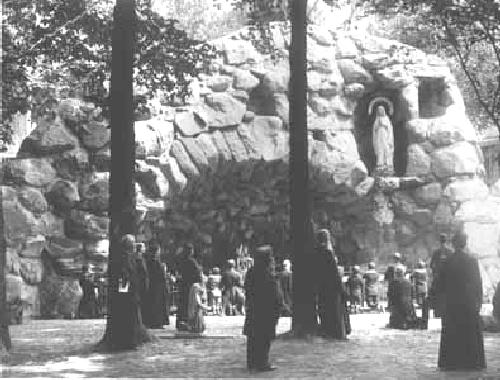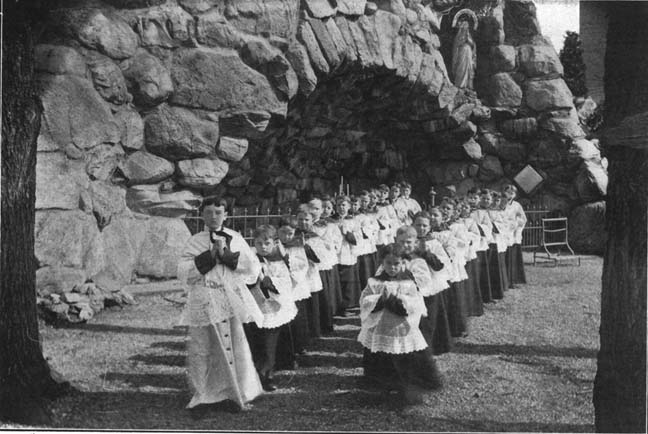
Notre Dame's Grotto / by Dorothy V. Corson


The Dedication of the Grotto
Father Maguire nears the end of his letter of correction concerning the 1896 Grotto with this brief description of a little known event that occurred as the Grotto was nearing its completion.
The "spring" actually did appear and old Father Letourneau felt it was a miracle since it appeared almost at the same spot as the one at Lourdes. But wiser people closed it up so as to prevent wild rumors regarding it.
This incident at the Notre Dame Grotto paralleled a similar occurrence that happened at the Grotto of Lourdes in France in 1858. When Bernadette scratched a hole in the dirt of the floor of the cave at Lourdes, a spring appeared. It became the origin of the Lourdes water that is still sent all over the world.
In August, another entry on the progress of the Grotto was published in the Annals confirming the information in Father Maguire's letter regarding the spring which appeared at the Grotto:
Grotto of Lourdes at Notre Dame, Indiana
We are glad to be able to say that the work on the Grotto at Notre Dame is progressing as well as one could expect under the circumstances. . . . The Grotto will be a thing of beauty and a great incentive to devotion to the Mother of God. We claim no miracles in this work, but we do claim that most remarkable coincidences mark the beginning and progress of this shrine. As has been announced already in the Annals, the first favor asked by the one who started the Grotto was granted on the first day of May, 1895. The second favor was a handsome contribution towards building it, and this came on the first day of May, 1896. Finally, while sinking the foundation the builders struck a beautiful spring of clear cold water in the same spot relatively as the one is found in the Grotto at Lourdes, France. The mechanics received orders to open the ground and wall the spring with rocks. To do this they were obliged to use a heavy pump which has a capacity of lifting from twenty-five to thirty gallons a minute. They kept this pump working for five hours before they could reduce the water. As fast as the water was pumped out the spring boiled up in place of the vacuum caused by the pump. These circumstances are given simply for what they are worth, without trying to impose on the credulity of anyone; but the facts remain. In the name of the Blessed Virgin we sincerely thank all who have contributed to this work. The Blessed Virgin knows how to reward her children.(154)
Very early pictures of the Grotto(155) show that an ordinary backyard pump for drinking water marked the spot where the natural spring appeared.
The Scholastic (156) reported this added bit of information. "A plaster of paris model of the proposed Grotto now stands in the back sacristy of Sacred Heart Church and indicates that an ornate shed was meant for the drinking well."
An earlier Annals, which described the progress of the Grotto, stated the proposed completion date:
The work on the foundation of the Grotto has commenced, and we hope to see it finished by the 15th of August next -- Feast of the Assumption.(157)
However, by accident or design, the dedication of the 1896 Notre Dame Grotto, originally planned for that date, occurred ten days earlier, on August 5, 1896, the Feast of Our Lady of the Snows.
Our Lady of Snows refers to St. Mary Major. This church is so-called because it is the major, the largest, and most illustrious shrine of Our Lady in the eternal city (Rome). . . . It is called Our Lady of the Snows because of the tradition that the original outline for the church was traced in snow, August 5, 358, after the prayer of a Roman patrician, John, and his wife. Childless, they had promised to make Our Lady heiress of their property, and sought in prayer for some intimation of her will.(158)
This was the same day Sorin departed from France for the New World in 1841. Sorin related the occurrence in his Chronicles . He wrote that he had "absolutely nothing to do with the choice of the day" and refers to it as a "happy coincidence" an intimation of her maternal protection. Had Sorin been there to witness the 1896 Grotto dedication, undoubtedly, he would have proclaimed it, another "happy coincidence." That, once again, she had chosen for herself, that date, as further reassurance of her inspirational guidance to all those "who look up to her" on the Dome and at the Grotto "as their guiding Star."

The Grotto's Dedication
In September of 1896, the last entry in the Annals described more fully the occasion of the Grotto's dedication:
Grotto of Lourdes at Notre Dame, Indiana
On August 5th, 1896, the Feast of Our Lady of Snows, a beautiful statue representing the Blessed Virgin as she appeared to Bernadette at Lourdes was set in place in the new Grotto here at Notre Dame. The ceremony of the occasion, though short, partook of a simple grandeur that is not usually seen outside of Catholic countries. In the cool hours of the morning the Religious of the Holy Cross -- priests, brothers and nuns -- to the number of five hundred or more assembled in the spacious College Chapel to assist at Solemn Mass. All who were present approached the Holy Table and, when the services were over, formed in procession leading across the University lawn and through the picturesque grove in which Our Lady's shrine is situated. The brothers were in front carrying the statue and telling their beads, while the acolytes and priests followed with candles and waving banners. The sisters, chaunting the Litany of Loretto and the Magnificat, walked behind the ministers of the Mass. Those who have never witnessed a procession of this kind cannot know the beauty and the glory of it. Hard indeed would be the heart which would not thrill at the sight. To be sure, we do not refer to the mere specular aspect of a number of men and women marching in picturesque habits through a wooded glen, -- though that in itself is something uncommonly striking; we have in mind, rather, the faith of which is hardly any left in our day. No man could gaze on such a scene without feeling in his inmost consciousness -- whatever his outward expression might be -- that in the Catholic Church faith at least is not dead. And when on this occasion, the statue was finally in place and the religious knelt down before Our Lady's image offering prayers of thanksgiving and supplication, it was clear beyond doubt that here at Notre Dame there exists a faith in the Blessed Virgin's power, before God which is as strong and living as that which existed in the very "Ages of Faith" themselves. It is gratifying to be able to say this much, for it means that blessings are in store for the home of the new Grotto as well as the country round about from which the pilgrimages come. When the statue and the Grotto had been blessed, a short sermon was preached by the Very Rev. William Corby, C.S.C., who gave in brief the history of the Grotto from the moment the first donation was received down to its present state of almost final completeness.(159)